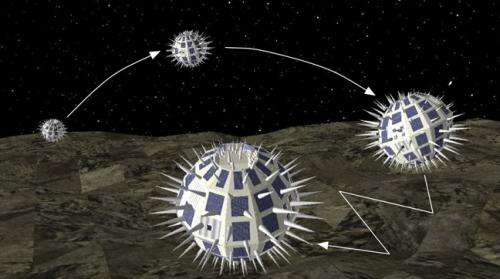Robotic spacecraft / rover hybrids for space exploration

The big news from space exploration is that small bodies in the cosmos offer tantalizing insight about the very formation of our solar system. So what strategy can be employed to inspect these mini-worlds in a systematic and affordable way?
The solution may be to sprinkle the solar system with robotic platforms.
Marco Pavone is an assistant professor of aeronautics and astronautics at Stanford University, and also a research affiliate at the NASA Jet Propulsion Laboratory in Pasadena, Calif.
Thanks to the NASA Innovative Advanced Concepts (NIAC) Program, Pavone is eying a new paradigm to explore comets and asteroids, as well as the small moons of Mars: Phobos and Deimos. His NIAC-supported research is titled “Spacecraft/Rover Hybrids for the Exploration of Small Solar System Bodies.”
Pavone’s work centers on developing robotic platforms capable of fast and precise mobility on the surface of small bodies within our solar system. On-the-spot robotic investigation of these exploration targets would not only shed light on how our solar system formed, he explains, but also sharpen the technologies needed for future human exploration of Earth.
What Pavone envisions is, quite plainly, taking on solar system exploration by leaps and bounds.
Making Use of Reduced Gravity
At first blush, having a robot “take a tumble” might sound a bit worrisome – but that’s exactly how Pavone envisions a way to move about on other worlds. The idea is to make use of the reduced gravity of small bodies.
Pavone’s mobility platforms would be unleashed by a mother spacecraft. Once on the surface of a small body, each platform would literally spring into action. Long vaults on the far out world could be accomplished by hopping. Short treks by a platform to select locations on the body are done through a sequence of controlled tumbles. High-altitude, point-to-point jumps by a platform are feasible too.
“The proposed robotic platforms would behave as spacecraft/rover hybrids, capable of accessing most destinations on virtually any small body,” Pavone says. By using multiple platforms, the landscape of a small body could be closely observed, sampled and measured. Another plus for using several units, according to Pavone, is that the loss of one hybrid would not spell the end of the mission.
The NIAC-backed investigation gives Pavone the opportunity to draw upon several fields of his expertise, from control theory, autonomous systems, coordination of multi-robot networks to formation flying and bio-inspired robotics.
“The systematic exploration of small bodies would help unravel the origin of the solar system and its early evolution, as well as assess their astrobiological relevance,” Pavone explains. “In addition, we can evaluate the resource potential of small bodies in view of future human missions beyond Earth.”
Provided by JPL/NASA




















